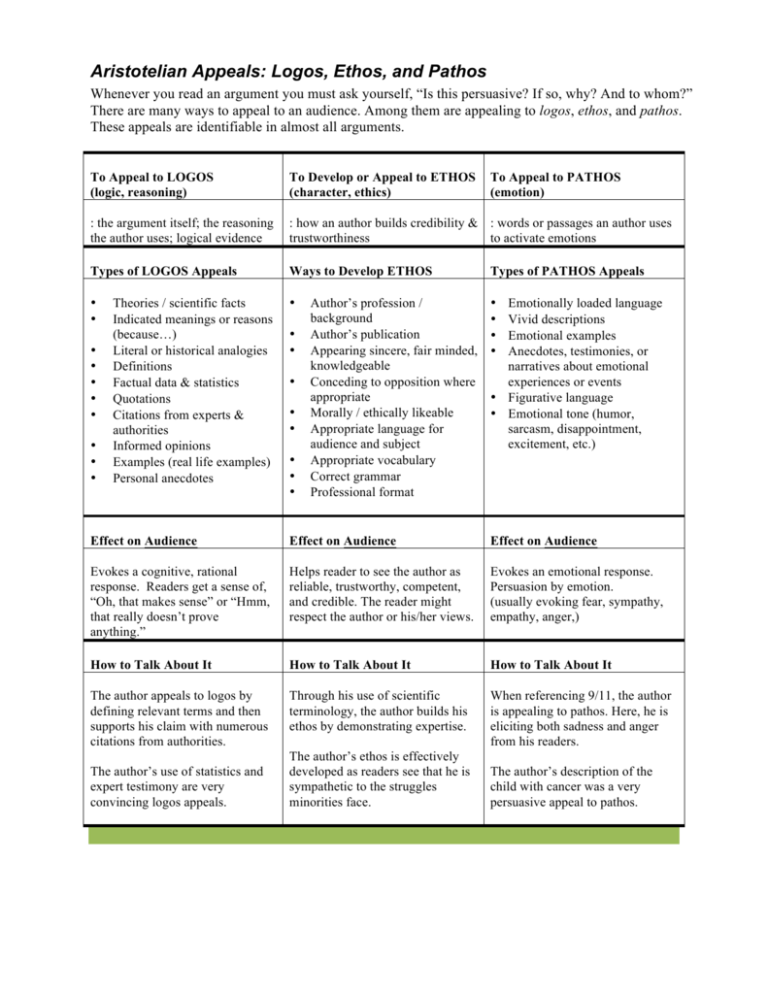05 Ethos pathos logos handout and Lesson Plan
advertisement

Aristotelian Appeals: Logos, Ethos, and Pathos Whenever you read an argument you must ask yourself, “Is this persuasive? If so, why? And to whom?” There are many ways to appeal to an audience. Among them are appealing to logos, ethos, and pathos. These appeals are identifiable in almost all arguments. To Appeal to LOGOS (logic, reasoning) To Develop or Appeal to ETHOS (character, ethics) : the argument itself; the reasoning the author uses; logical evidence : how an author builds credibility & : words or passages an author uses trustworthiness to activate emotions Types of LOGOS Appeals Ways to Develop ETHOS • • • • • • • • • • Theories / scientific facts Indicated meanings or reasons (because…) Literal or historical analogies Definitions Factual data & statistics Quotations Citations from experts & authorities Informed opinions Examples (real life examples) Personal anecdotes • • • • • • • • • Author’s profession / background Author’s publication Appearing sincere, fair minded, knowledgeable Conceding to opposition where appropriate Morally / ethically likeable Appropriate language for audience and subject Appropriate vocabulary Correct grammar Professional format To Appeal to PATHOS (emotion) Types of PATHOS Appeals Emotionally loaded language Vivid descriptions Emotional examples Anecdotes, testimonies, or narratives about emotional experiences or events • Figurative language • Emotional tone (humor, sarcasm, disappointment, excitement, etc.) • • • • Effect on Audience Effect on Audience Effect on Audience Evokes a cognitive, rational response. Readers get a sense of, “Oh, that makes sense” or “Hmm, that really doesn’t prove anything.” Helps reader to see the author as reliable, trustworthy, competent, and credible. The reader might respect the author or his/her views. Evokes an emotional response. Persuasion by emotion. (usually evoking fear, sympathy, empathy, anger,) How to Talk About It How to Talk About It How to Talk About It The author appeals to logos by defining relevant terms and then supports his claim with numerous citations from authorities. Through his use of scientific terminology, the author builds his ethos by demonstrating expertise. When referencing 9/11, the author is appealing to pathos. Here, he is eliciting both sadness and anger from his readers. The author’s use of statistics and expert testimony are very convincing logos appeals. The author’s ethos is effectively developed as readers see that he is sympathetic to the struggles minorities face. The author’s description of the child with cancer was a very persuasive appeal to pathos. Introducing the Aristotelian Appeals: Advertisement Activity Alicia Upano Time: Materials: Overview: 50-­‐75 minutes Logos, Ethos, Pathos Handout, advertisement overheads or online commercial, follow-­‐up HW assignment on a visual or written text First, introduce students to the Aristotelian appeals. Then, have students recognize and discuss the different appeals in three appropriate advertisements. Next, assign group work where students create their own advertisements and share with the class. Last, assign additional work where students must do a rhetorical analysis or either a visual or written text. Warm-­‐up: 5-­‐15 minutes 1. Give students background information on the appeals. a. Remind students that our focus is on what a text does, not on what it says. When performing rhetorical analyses of arguments, we look at what “moves” an author makes in hopes of persuading his claims. b. Write on the board ‘Aristotelian Appeals’. Ask, “What word/name can we pull from this term?” c. Give background: In Ancient Greece, Aristotle (our “father” of rhetoric) studied the art of persuasion and found that the ways all rhetors appeal to their audiences can be categorized in three ways. d. Write on the board ‘Logos, Ethos, Pathos.’ Elicit student responses to guess what these different appeals are (think roots: logos/logic; ethos/ethics; pathos/sympathy) e. Have students brainstorm and call out how might rhetors appeal to an audience using logos. Ethos? Pathos? Jot down their answers on the board. Also consider showing this short video (6 minutes or so) explaining the Aristotelian appeals. It’s a bit corny (made for middle school students), but it gets the job done. This can be used in addition to or in replacement of your introduction. http://www.teachertube.com/view_video.php?viewkey=8e6ffede7cf8b4825fe3 Introduce the Aristotelian Appeals using the Handout and Overheads: 10-­‐15 minutes 1. Pass out the Logos, Ethos, Pathos handout. Go over the handout with the class. Point out the language that is used when talking about the appeals. 2. When appropriate, make comments connecting back to the email activity. See the examples below for help. a. In writing a persuasive email to the instructor, how did the student appeal to logos? i. Reasoning: x happened, so it was impossible to be in class ii. Doctor’s note / death certificate iii. Letter from coach b. Ethos? i. Apologize / take responsibility ii. Greet professor professionally / “speak” respectfully iii. Assure your proactive, hardworking, willing to do what it takes c. Pathos? i. Tell a sad story of what happened ii. Tell a sad story of what will happen if you fail iii. Plead for forgiveness 3. Show different advertisements (overheads or commercials) and discuss how each appeals to the audience. You can take time here discussing the visual text’s argument and audience. Make sure students use academic language to analyze and discuss the ad (see the examples on the handout). a. Talk about the ads rhetorically i. What is the ad DOING (what rhetorical appeal? To what audience?) ii. How is the ad DOING it? (describe what’s going on) iii. Is it effective? (use analytical term) Assign Additional Work in Class or for HW (5-­‐20 minutes) In-­‐class Activities for Creating Ads using Ethos/Pathos/Logos 1) Three Large Groups Creating an Ad Divide the class into three large groups (8-­‐9 students each). Do one of the following. a) Assign each group the task of creating an ad for A) ethos, B) pathos, or C) logos. This activity is most effective if you use the same company, say Nike, for the whole class. This way they can see how very different the same product can be promoted depending on which rhetorical appeal is emphasized. Groups share in class and/or write something up as homework. b) Assign each group the task of creating an ad where they must persuade their audience using ALL three of the appeals. This can help to emphasize the idea that most arguments utilize a balance of ethos, pathos, and logos when attempting to convince their audience. Assign various or the same company or let students choose. Groups share in class and/or write something up as homework. 2) Several Small Groups Creating an Ad Ask your class to get into groups of three and assign each group to one box in the chart below. Groups share in class and/or write something up as homework. UPS Coca Cola Nike Ethos Group A B C Pathos D E F Logos G H I Regardless of which group size you choose, you will then need to assign the type of ad they will be creating: a) Magazine Ad You may want to bring in blank overhead sheets and markers to allow each group to create a layout of what their magazine page would look like. b) Television Commercial Your students can describe their proposed commercial frame by frame, or get up together as a group and narrate/act it out that class or the next. 3) Give a Pitch to a Company A third option can be either an in-­‐class or take home assignment and it can also be done in groups or individually. The students, pretending they are advertising executives, will write a sales pitch to a company with a proposed advertisement. They need to use persuasive language and all three rhetorical appeals when describing not just what their advertisement will be, but also how it will work. For example: (to Nike executives) The ad will never actually use the word “Nike” but instead, will have your signature swoosh at the bottom of the image. We believe that because your company is so well-­‐known and has firmly built up its ethos that using both “Nike” and the swoosh seems redundant. The ever presence of the swoosh will represent your company’s strong foundation. Out -­‐of-­‐class Writing Assignments for Analyzing Ads using Ethos/Pathos/Logos 1) Analyze a Magazine Ad Students find an ad online, print it out, and write a one page rhetorical analysis focusing on how the ad appeals to logos, ethos, and/or pathos. 2) Analyze Your own Advertisement Students draw or write-­‐up an advertisement (either created in class with their groups or on their own at home). Then, students write a one page analysis of their advertisement focusing on how it appeals to logos, ethos, and/or pathos. 3) Analyze a Written Text Students are assigned to read a pre-­‐selected short text at home and write a one page analysis describing how the author appeals to logos, pathos, and/or ethos.







